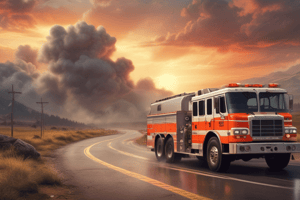Podcast
Questions and Answers
What is the primary role of the Branch Directors in the Incident Command Structure?
What is the primary role of the Branch Directors in the Incident Command Structure?
- To oversee the logistics section exclusively
- To provide coordination between Divisions/Groups and Incident Command (correct)
- To manage finance and administration functions
- To act as the Incident Commander
Which section of the Incident Command Structure is responsible for public information?
Which section of the Incident Command Structure is responsible for public information?
- Logistics
- Planning
- Public Information Liaison (correct)
- Operations
In which geographical division would a 'multi-story structure' be categorized?
In which geographical division would a 'multi-story structure' be categorized?
- Division 6
- Division 10 (correct)
- Division 8
- Division 2
What is a key indicator that the Incident Commander may implement an additional intermediate level known as Branching?
What is a key indicator that the Incident Commander may implement an additional intermediate level known as Branching?
Which of the following positions is NOT a part of the Command Procedures as outlined?
Which of the following positions is NOT a part of the Command Procedures as outlined?
Which of the following is the primary function of the Logistics Section Chief?
Which of the following is the primary function of the Logistics Section Chief?
Which of the following best describes the role of the Operations Section Chief?
Which of the following best describes the role of the Operations Section Chief?
What organizational change occurs once the incident organization experiences increased complexity?
What organizational change occurs once the incident organization experiences increased complexity?
What is the primary intent of the Branch Level in the Incident Command structure?
What is the primary intent of the Branch Level in the Incident Command structure?
In what scenario should Branch Directors be utilized according to the Incident Command structure?
In what scenario should Branch Directors be utilized according to the Incident Command structure?
Which of the following is NOT a type of incident where Branch Directors should be utilized?
Which of the following is NOT a type of incident where Branch Directors should be utilized?
What is one responsibility of Branch Directors during incidents?
What is one responsibility of Branch Directors during incidents?
How should communication be handled by Branch Directors?
How should communication be handled by Branch Directors?
What type of incidents require the assignment of Branch Directors to forward positions?
What type of incidents require the assignment of Branch Directors to forward positions?
Which of the following best describes a responsibility of Branch Directors in a multi-agency response?
Which of the following best describes a responsibility of Branch Directors in a multi-agency response?
Which of the following is a valid radio designation for a Branch?
Which of the following is a valid radio designation for a Branch?
What key information should be communicated to Division/Group Supervisors when Branches are implemented?
What key information should be communicated to Division/Group Supervisors when Branches are implemented?
How should radio communications be directed once Branches are in place?
How should radio communications be directed once Branches are in place?
What is a typical location for Branch Directors during an incident?
What is a typical location for Branch Directors during an incident?
What role do Branch Directors play in managing incidents spread over large areas?
What role do Branch Directors play in managing incidents spread over large areas?
What should be done to monitor Branch radio channels during extended operations?
What should be done to monitor Branch radio channels during extended operations?
What happens as a small incident expands into a major operation?
What happens as a small incident expands into a major operation?
Which of the following accurately describes the Division/Group Supervisors' role during Branch implementation?
Which of the following accurately describes the Division/Group Supervisors' role during Branch implementation?
What personnel should be involved to fill section positions in an expanded Incident Command Team?
What personnel should be involved to fill section positions in an expanded Incident Command Team?
Study Notes
Incident Command Structure
- Incident Commander oversees the entire operation and is supported by various positions including Public Information Liaison and Safety.
- Command is broken down into four main sections: Operations, Planning, Logistics, and Finance/Admin; each led by a Section Chief.
- Branch Directors coordinate between Divisions/Groups and the Incident Commander, especially during complex incidents.
Organizational Expansion
- Branching is implemented when an incident grows in complexity or scope to improve communication and coordination.
- Branch Directors supervise multiple Division/Group Supervisors and report directly to the Incident Commander.
Communication Protocol
- When branches are established, Division/Group Supervisors must be informed of their new assignments, including the branch and radio channel operated on.
- Communication should flow from Division/Group Supervisors to Branch Directors instead of directly to the Incident Commander.
Forward Operations
- Branch Directors may operate remotely or at the Incident Command Post, depending on situational effectiveness.
- In cases of large incidents, Branch Directors should utilize command vehicles for forward positioning to facilitate effective coordination.
Incident Segmentation
- Increased complexity in incidents may require an expanded organizational structure involving Command Officers and staff for section positions.
- Different levels of management are identified: Strategic Level (Incident Commander), Coordination Level (Branch Directors), Tactical Level (Division/Group Supervisors), and Task Level (Company Officers).
Appropriate Use of Branches
- Branches should be employed during incidents that exceed the control limits of the Incident Commander or involve distinctly different major components.
- Examples include: Hazmat situations needing evacuations, large wildland fires, mass casualty incidents, and complex situations involving multiple response disciplines.
- Effective management of communications and establishment of staging areas by Branch Directors is crucial.
Radio Communications
- Each Branch may have designated radio communications that reflect its function or geographic area, aiding in coordinated response efforts.
Studying That Suits You
Use AI to generate personalized quizzes and flashcards to suit your learning preferences.
Related Documents
Description
This quiz covers the essential command procedures for emergency management communications. It focuses on the roles and responsibilities of key personnel including the Incident Commander, Public Information Liaison, and various section chiefs. Test your understanding of the communication flow in incident management.




